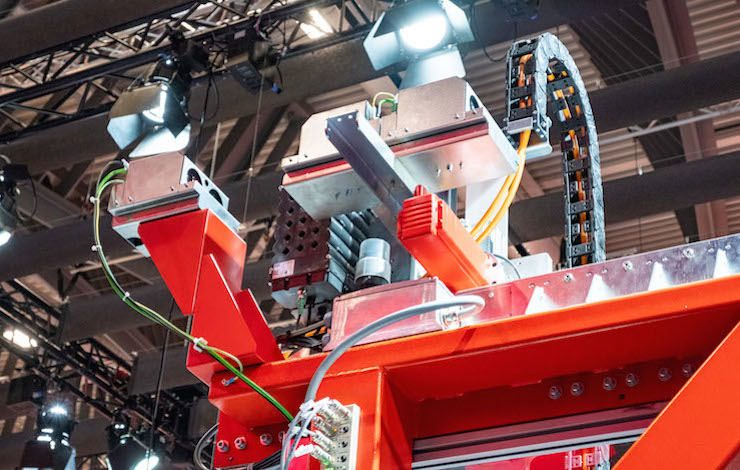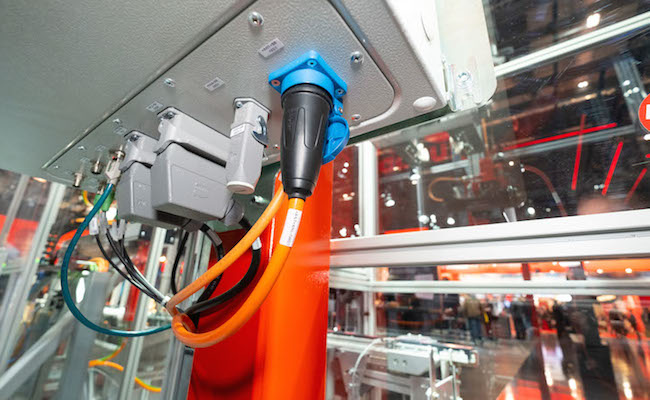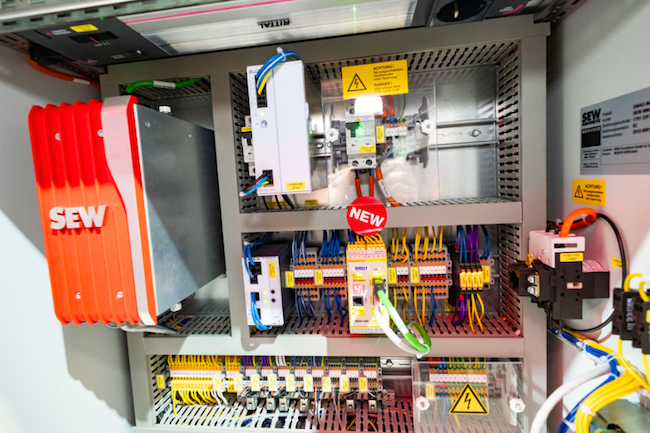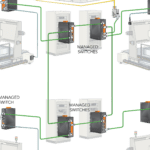One of the more promising recent developments in connection technology is contactless energy and data transfer and its use in the industrial world. Such technology can replace wiring and cables and cable carriers, lowering costs and streamlining designs. For instance, robotic systems are sometimes limited by constraints in automation and drive technology. However, consider the case of a gantry robot that uses contactless energy and data transfer instead of fixed wiring runs and cable carriers.
Gantry robots are a tried-and-tested solution for intralogistics material flows within a machine or application. They’re commonly used to detect products automatically, grip them securely and quickly, and take them to their destination. This type of robot is useful in many industries, and can be used for a wide range of product sizes and weights, and distances to be covered. Oftentimes, the lengths of power and communication cables and cable carriers limit the flexibility and adaptability of an existing machine to a new production scenario. But adding contactless energy and data transfer opens up new possibilities.
Less noise, enhanced dynamics, greater flexibility
Contactless energy and data transfer combined with intelligent software and reliable mechatronics can form a fully integrated solution. Using contactless energy transfer, multiple robots can move freely on the same horizontal stretch of rail, greatly increasing the flexibility of the gantry robot. This regularly leads to overlapping sections between robots – ultimately offering a great deal of freedom in terms of machine design and operations. Logistics processes of this kind would not be as easy to implement with cable carriers, because of the additional area that carriers use along the entire distance of the system. Plus, cable carriers generate noise, are subject to wear, increase inertia, and have an overall negative impact on both dynamics and energy efficiency due to the friction they generate.

Another benefit of contactless energy and communication transfer is that there are no restrictions regarding installation space, cable breakage or limited cycle rates – issues all associated with cable carriers and moving cables. It’s made possible by a contactless inductive energy transfer system, including a decentralized power supply module. Depending on the design, this module delivers a transmission power between 5 and 11 hp.
Another benefit is that throughout the entire load cycle, the robot consumes less than 0.7 hp via the pick-up – even though the horizontal axis alone requires more than 5 hp of acceleration power. The short-term energy requirements are met by the energy storage unit, a double-layer capacitor package that takes care of the primary energy supply to the robot with a dc link voltage of 100 V. The typical travel profiles of a gantry robot, which involve alternating acceleration and braking phases, led to the idea of retaining the regenerative energy generated during braking within the process instead of dissipating it via resistors. The energy storage unit absorbs this braking energy and also functions as a booster when the gantry’s drives accelerate at 20 ft/sec2. The contactless energy transfer and storage system only has to compensate for the system’s mechanical efficiency losses, which amount to around 0.7 hp. Unlike the familiar dc link connection of multi-axis applications, which is located in the central control cabinet, each unit is enabled to store energy independently. This makes it easy and convenient to scale the system.

Cable-free communication
The robot gantry’s contactless energy transfer system, which eliminates the need for restrictive cables, also extends to the communication processes. Here, an EtherCAT data light barrier transfers the interpolated position setpoints from the central motion controller to the four servo inverters in the moving housing box at 1 msec intervals. A motion controller calculates the complex robot motion control – and can do so for up to four robots at once. Motion control involves performing calculations and coordinating the robots to prevent collisions. If a machine in a production network requires double the material flow output, the gantry system gives users the option to move a robot from another section on a flexible basis. Handling units that draw their power with cables, in contrast, are tied to their section. As a result, the associated resources become movable and systems as a whole are more flexible and productive. Entirely new machine concepts can be created based on this approach.
Optical real-time communication
The automation provider opted to use the real-time Ethernet protocol EtherCAT in the gantry – once again dispensing with cables by implementing an optical connection to the mobile units. The drive data can be delivered to the robots via data light barriers. There are no separate motion controllers in each robot as one does the job of running the whole robotic system. With each cycle taking 1 msec, the optical system has practically no latency periods when transmitting the interpolated position setpoints to the inverters or feeding back the relevant actual values.

Communication for the functional safety technology works in the same way. The application uses a central safety controller for all robots and the machine as a whole. This safety controller communicates directly with the SEW Eurodrive MOVI C automation controller via EtherCAT using the EtherCAT FSoE (Fail Safe over EtherCAT) protocol. This setup lets both controllers share data with ease, simplifies programming considerably, and offers excellent conditions for diagnostics and debugging. The seamless integration of the FSoE safety master and
the EtherCAT data light barrier are integrated into a comprehensive automation solution including motors, electronics and visualization.
SEW Eurodrive
www.seweurodrive.com






Leave a Reply
You must be logged in to post a comment.